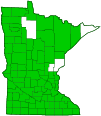smooth scouring rush
(Equisetum laevigatum)
Conservation • Wetland • Description • Habitat • Ecology • Use • Distribution • Taxonomy
Description |
||
Smooth scouring rush is an erect, 12″ to 36″ tall, unbranched perennial that rises from rhizomes. The stems are erect, ⅛″ to 5 ⁄16″ in diameter, light green, and hollow. They are normally unbranched, but may develop one or a few branches after injury, or in the second year. They have 10 to 32, usually at least 16, fine, vertical ridges that are smooth to the touch. They are annual, lasting less than one year. The central cavity is ⅔ to ¾ the diameter of the stem. The portion of the stem between the nodes is up to several inches near the bottom, becoming progressively shorter as they ascend the stem. The leaves are reduced in size, fused together for most of their length, and appressed against the stem, forming a collar-like sheath around the nodes. The sheaths are a lighter shade of green than the stem, usually with a black band at the tip only, sometimes also the lowest ones with a black band at the base or black throughout. They are longer than wide, ¼″ to ⅝″ long, ⅛″ to ⅜″ wide. At the tip of the sheath are 10 to 32, usually at least 16, free lobes appearing as tiny, black teeth. The teeth are jointed and fall off at the joint promptly at maturity, leaving just a dark rim on the sheath. A solitary, spore-bearing cone is borne at the end of each fertile stem. The cone is ⅜″ to 1″ long, circular in cross-section, and elliptic in long section, and rounded at the tip. It often ends with a tiny, inconspicuous, abrupt, flexible point at the tip (apiculate). Infertile stems are similar to fertile stems but lack the terminal cone. The cone falls off after releasing spores. |
||
Height |
||
12″ to 36″ |
||
Similar Species |
||
Scouring rush horsetail (Equisetum hymale ssp. affine) is a taller plant, usually reaching 24″ to 48″ tall. The stems are darker green, rough to the touch, and evergreen. The sheaths appear squarish, are tan, grayish, or white, and have a black band at both the base and the tip. The teeth on the sheath often persist after maturity. The cones are conspicuously apiculate. Variegated scouring rush (Equisetum variegatum ssp. variegatum), is a shorter plant, only 4″ to 18″ tall. The stems are thinner, 1 ⁄32″ to 3 ⁄32″ in diameter. The sheaths are slightly flared outwards at the tip. There are 5 to 12 vertical ridges on the stem and the same number of teeth on the sheath. The teeth have conspicuous white margins. The teeth are not jointed and usually persist. The cone is shorter, ⅜″ long or less. It is found only in the upper third of the state. |
||
Habitat |
||
Wet meadows, prairies. |
||
Ecology |
||
Sporulation |
||
|
||
Pests and Diseases |
||
|
||
Use |
||
The stems are unbranched or have few irregular branches. They are coated with an abrasive silica, and were used for scrubbing cooking pots. This, along with their rush-like appearance, gave rise to the common name “scouring rush”. |
||
Distribution |
||||
|
Sources |
|||
| 6/8/2023 | ||||
Nativity |
||||
Native |
||||
Occurrence |
||||
Common |
||||
Taxonomy |
|||
| Kingdom | Plantae (Plants) | ||
| Division | Tracheophyta (Vascular Plants) | ||
| Subdivision | Polypodiophytina | ||
| Class | Polypodiopsida (ferns) | ||
| Subclass | Equisetidae (horsetails) | ||
Order |
Equisetales (horsetails) | ||
Family |
Equisetaceae (horsetail) | ||
Genus |
Equisetum (horsetails) | ||
| Subgenus | Hippochaete (scouring rushes) | ||
Monotypic genus, family, and order Subgenus Living fossil |
|||
Subordinate Taxa |
|||
|
|||
Synonyms |
|||
Equisetum funstoni Equisetum funstonii Equisetum kansanum Equisetum laevigatum ssp. funstonii Hippochaete laevigata |
|||
Common Names |
|||
horsetail smooth horsetail smooth scouring rush smooth scouring-rush smooth scouringrush |
|||
Glossary
Apiculate
Ending in a short, abrupt, flexible point.
Node
The small swelling of the stem from which one or more leaves, branches, or buds originate.
Rhizome
A horizontal, usually underground stem. It serves as a reproductive structure, producing roots below and shoots above at the nodes.
Visitor Photos |
|||||
Share your photo of this plant. |
|||||
| This button not working for you? Simply email us at info@MinnesotaSeasons.com. Attach one or more photos and, if you like, a caption. |
|||||
|
|||||
MinnesotaSeasons.com Photos |
|||||
Plant |
|||||
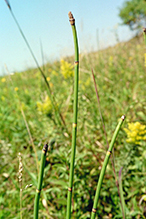 |
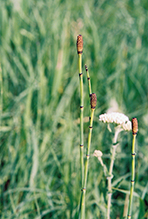 |
||||
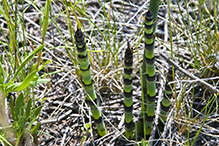 |
|||||
Stem |
|||||
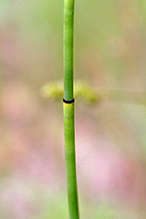 |
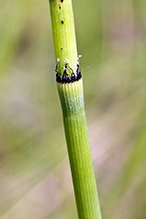 |
||||
Irregularly Branched Stem |
|||||
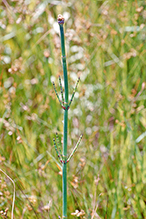 |
|||||
Cone |
|||||
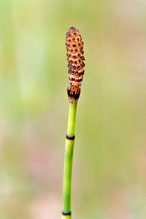 |
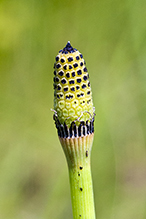 |
||||

Slideshows |
||

Visitor Videos |
|||
Share your video of this plant. |
|||
| This button not working for you? Simply email us at info@MinnesotaSeasons.com. Attach a video, a YouTube link, or a cloud storage link. |
|||
Other Videos |
|||

Visitor Sightings |
|||||
Report a sighting of this plant. |
|||||
| This button not working for you? Simply email us at info@MinnesotaSeasons.com. Be sure to include a location. |
|||||
|
|||||
MinnesotaSeasons.com Sightings |
|||||
Felton Prairie SNA, Bicentennial Unit Felton Prairie SNA, Shrike Unit Kellogg Weaver Dunes SNA, Kellogg Weaver Unit Kellogg Weaver Dunes SNA, Weaver Dunes Unit Lake Alexander Woods SNA, South Unit Margherita Preserve-Audubon Prairie Mound Spring Prairie SNA, North Unit Mound Spring Prairie SNA, South Unit Northern Tallgrass Prairie NWR, Hoffman Unit Northern Tallgrass Prairie NWR, Pavia Unit Northern Tallgrass Prairie NWR, Spieker Unit Northern Tallgrass Prairie NWR, Touch the Sky Prairie Unit P.N. and G.M. Nelson Wildlife Sanctuary Pankratz Memorial Prairie, North Unit Pembina Trail Preserve SNA, Crookston Prairie Unit Prairie Creek WMA, Koester Prairie Unit Two Rivers Aspen Prairie Parkland SNA |
|||||

|
Created: Last Updated: © MinnesotaSeasons.com. All rights reserved. |
